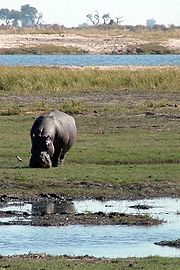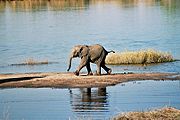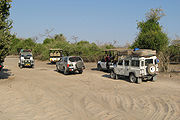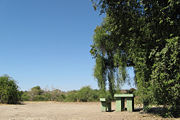
Chobe National Park
Encyclopedia
Chobe National Park, in northwest Botswana
, has one of the largest concentrations of game
in Africa
. By size, it is the third largest park of the country, after the Central Kalahari Game Reserve
and the Gemsbok National Park, and is the most diverse. It is also the country's first national park.
 The park can be divided up to 4 areas, each corresponding to one distinct ecosystem
The park can be divided up to 4 areas, each corresponding to one distinct ecosystem
:

(also known as the Basarwa people in Botswana
). They were nomadic hunter-gatherers who were constantly moving from place to place to find food sources, namely fruits, water and wild animals. Nowadays one can find San paintings inside rocky hills of the park.
At the beginning of the 20th century, the region that would become Botswana
was divided up to different land tenure systems. At that time, a major part of the park's area was classified as crown land
. The idea of a national park
to protect the varied wildlife found here as well as promote tourism
first appeared in 1931. The following year, 24'000 km² around Chobe district
were officially declared non-hunting area; this area was expanded to 31'600 km² two years later.
In 1943, heavy tsetse infestations occur throughout the region, making the idea of creating a national park momentarily left aside. It was only in 1953 that this project received governmental attention again: 21'000 km² were suggested to become a game reserve. As a result, the Chobe Game Reserve was born in 1960 with an area smaller than originally wanted. Finally, in 1967, the reserve was declared a national park.
At that time there were several industrial settlements in the region, especially at Serondela, where the timber industry proliferated. These settlements were gradually moved out of the park, and it was not until 1975 that the whole protected area was exempt from human activity. Nowadays traces of the old timber industry are still visible at Serondela. Minor expansions of the park took place in 1980 and 1987.
 The park is probably best known for its spectacular elephant population: It contains an estimated 50,000 elephants, perhaps the highest elephant concentration of Africa, and part of the largest continuous surviving elephant population. The elephant population seems to have solidly built up since 1990, from a few thousand.
The park is probably best known for its spectacular elephant population: It contains an estimated 50,000 elephants, perhaps the highest elephant concentration of Africa, and part of the largest continuous surviving elephant population. The elephant population seems to have solidly built up since 1990, from a few thousand.
Elephants living here are Kalahari elephants, the largest in size of all known elephant populations. They are characterized by rather brittle ivory
and short tusk
s, perhaps due to calcium deficiency in the soils.
Damage caused by the high numbers of elephants is rife in some areas. In fact, concentration is so high throughout Chobe that culls have been considered, but are too controversial and have thus far been rejected.
At dry season, these elephants sojourn in Chobe River and the Linyanti River areas. At rain season, they make a 200-km migration to the southeast stretch of the park. Their distribution zone however outreaches the park and spreads to northwestern Zimbabwe
.
 There are three main camping sites within the park, all of which are equipped with shower-toilets facilities and require booking in advance:
There are three main camping sites within the park, all of which are equipped with shower-toilets facilities and require booking in advance:
 4-wheel vehicles are usually used for transfer between camps, as the road network here is recent and relatively primitive. The road is best near the Chobe River. However it exists no facility between Maun
4-wheel vehicles are usually used for transfer between camps, as the road network here is recent and relatively primitive. The road is best near the Chobe River. However it exists no facility between Maun
and Kasane
. Therefore it is always safe for tourists to carry with them basic items such as food, water or tools.
This park is considered for inclusion in the 5 Nation Kavango - Zambezi Transfrontier Conservation Area.
Botswana
Botswana, officially the Republic of Botswana , is a landlocked country located in Southern Africa. The citizens are referred to as "Batswana" . Formerly the British protectorate of Bechuanaland, Botswana adopted its new name after becoming independent within the Commonwealth on 30 September 1966...
, has one of the largest concentrations of game
Game (food)
Game is any animal hunted for food or not normally domesticated. Game animals are also hunted for sport.The type and range of animals hunted for food varies in different parts of the world. This will be influenced by climate, animal diversity, local taste and locally accepted view about what can or...
in Africa
Africa
Africa is the world's second largest and second most populous continent, after Asia. At about 30.2 million km² including adjacent islands, it covers 6% of the Earth's total surface area and 20.4% of the total land area...
. By size, it is the third largest park of the country, after the Central Kalahari Game Reserve
Central Kalahari Game Reserve
Central Kalahari Game Reserve is an extensive national park in the Kalahari desert of Botswana. Established in 1961 it covers an area of 52,800 km² making it the second largest game reserve in the world.The park contains wildlife such as giraffe, brown hyena, warthog, cheetah, wild dog,...
and the Gemsbok National Park, and is the most diverse. It is also the country's first national park.
Geography and ecosystems

Ecosystem
An ecosystem is a biological environment consisting of all the organisms living in a particular area, as well as all the nonliving , physical components of the environment with which the organisms interact, such as air, soil, water and sunlight....
:

- The Serondela area (or Chobe riverfront), situated in the extreme Northeast of the park, has as its main geographical features lush floodplains and dense woodland of mahogany, teak and other hardwoods now largely reduced by heavy elephant pressure. The Chobe, which flows along the Northeast border of the park, is a major watering spot, especially in the dry season (May through October) for large breeding herds of elephants, as well as families of giraffe, sable and cape buffalo. The flood plains are the only place in Botswana where the puku antelope can be seen. Birding is also excellent here. Large numbers of carmine bee eaters are spotted in season. When in flood spoonbills, ibis, various species of stork, duck and other waterfowl flock to the area. This is probably the most visited park section, partly because of its proximity to the Victoria FallsVictoria FallsThe Victoria Falls or Mosi-oa-Tunya is a waterfall located in southern Africa on the Zambezi River between the countries of Zambia and Zimbabwe.-Introduction:...
. The town of KasaneKasaneKasane is a town in Botswana, close to Africa's 'Four Corners', where four countries almost meet: Botswana, Namibia, Zambia and Zimbabwe. It is at the far north-eastern corner of Botswana where it serves as the administrative center of the Chobe District...
, situated just downstream, is the most important town of the region and serves as northern entrance to the park.
- The Savuti Marsh area, 10 878 km² large, constitutes the western stretch of the park (50 km north of Mababe Gate). The Savuti Marsh is the relic of a large inland lakeLakeA lake is a body of relatively still fresh or salt water of considerable size, localized in a basin, that is surrounded by land. Lakes are inland and not part of the ocean and therefore are distinct from lagoons, and are larger and deeper than ponds. Lakes can be contrasted with rivers or streams,...
whose water supply was cut a long time ago by tectonic movementPlate tectonicsPlate tectonics is a scientific theory that describes the large scale motions of Earth's lithosphere...
s. Nowadays the marsh is fed by the erratic Savuti Channel, which dries up for long periods then curiously flows again, a consequence of tectonic activity in the area. It is currently flowing again and in January 2010 reached Savuti Marsh for the first time since 1982. As a result of this variable flow, there are hundred of dead trees along the channel's bank. The region is also covered with extensive savannaSavannaA savanna, or savannah, is a grassland ecosystem characterized by the trees being sufficiently small or widely spaced so that the canopy does not close. The open canopy allows sufficient light to reach the ground to support an unbroken herbaceous layer consisting primarily of C4 grasses.Some...
hs and rolling grasslandGrasslandGrasslands are areas where the vegetation is dominated by grasses and other herbaceous plants . However, sedge and rush families can also be found. Grasslands occur naturally on all continents except Antarctica...
s, which makes wildlife particularly dynamic in this section of the park. At dry seasonDry seasonThe dry season is a term commonly used when describing the weather in the tropics. The weather in the tropics is dominated by the tropical rain belt, which oscillates from the northern to the southern tropics over the course of the year...
s, tourists going on safariSafariA safari is an overland journey, usually a trip by tourists to Africa. Traditionally, the term is used for a big-game hunt, but today the term often refers to a trip taken not for the purposes of hunting, but to observe and photograph animals and other wildlife.-Etymology:Entering the English...
often view warthogWarthogThe Warthog or Common Warthog is a wild member of the pig family that lives in grassland, savanna, and woodland in Sub-Saharan Africa. In the past it was commonly treated as a subspecies of P...
s, kuduKuduThe kudus are two species of antelope of the genus Tragelaphus:*Lesser Kudu, Tragelaphus imberbis*Greater Kudu, Tragelaphus strepsiceros- Etymology :...
s, impalaImpalaAn impala is a medium-sized African antelope. The name impala comes from the Zulu language meaning "gazelle"...
s, zebraZebraZebras are several species of African equids united by their distinctive black and white stripes. Their stripes come in different patterns unique to each individual. They are generally social animals that live in small harems to large herds...
s, wildebeestWildebeestThe wildebeest , also called the gnu is an antelope of the genus Connochaetes. It is a hooved mammal...
s and above all elephantElephantElephants are large land mammals in two extant genera of the family Elephantidae: Elephas and Loxodonta, with the third genus Mammuthus extinct...
s bullying each other. At rain seasons, the rich birdlife of the park (450 species in the whole park) is well represented. Packs of lionLionThe lion is one of the four big cats in the genus Panthera, and a member of the family Felidae. With some males exceeding 250 kg in weight, it is the second-largest living cat after the tiger...
s, hyenaHyenaHyenas or Hyaenas are the animals of the family Hyaenidae of suborder feliforms of the Carnivora. It is the fourth smallest biological family in the Carnivora , and one of the smallest in the mammalia...
s, zebraZebraZebras are several species of African equids united by their distinctive black and white stripes. Their stripes come in different patterns unique to each individual. They are generally social animals that live in small harems to large herds...
s or more rarely cheetahCheetahThe cheetah is a large-sized feline inhabiting most of Africa and parts of the Middle East. The cheetah is the only extant member of the genus Acinonyx, most notable for modifications in the species' paws...
s are visible as well. This region is indeed reputed for its annual migration of zebraZebraZebras are several species of African equids united by their distinctive black and white stripes. Their stripes come in different patterns unique to each individual. They are generally social animals that live in small harems to large herds...
s and predators.
- The Linyanti Marsh, located at the Northwest corner of the park and to the North of Savuti, is adjacent to Linyanti River. To the west of this area lies Selinda Reserve and on the Northern bank of Kwando River is NamibiaNamibiaNamibia, officially the Republic of Namibia , is a country in southern Africa whose western border is the Atlantic Ocean. It shares land borders with Angola and Zambia to the north, Botswana to the east and South Africa to the south and east. It gained independence from South Africa on 21 March...
's Mamili National ParkMamili National ParkMamili National Park is a national park in Namibia.Mamili is centered on the Nkasa and Lupala islands on the Kwando and Linyanti rivers in the south-western corner of East Caprivi...
. Around these 2 rivers are riverine woodlands, open woodlands as well as lagoons, and the rest of the region mainly consists of flood plains. There are here large concentrations of lionLionThe lion is one of the four big cats in the genus Panthera, and a member of the family Felidae. With some males exceeding 250 kg in weight, it is the second-largest living cat after the tiger...
s, leopardLeopardThe leopard , Panthera pardus, is a member of the Felidae family and the smallest of the four "big cats" in the genus Panthera, the other three being the tiger, lion, and jaguar. The leopard was once distributed across eastern and southern Asia and Africa, from Siberia to South Africa, but its...
s, wild dogsAfrican Wild DogLycaon pictus is a large canid found only in Africa, especially in savannas and lightly wooded areas. It is variously called the African wild dog, African hunting dog, Cape hunting dog, painted dog, painted wolf, painted hunting dog, spotted dog, or ornate wolf...
, Roan antelopeRoan AntelopeThe Roan Antelope is a savanna antelope found in West, Central, East Africa and Southern Africa.Roan Antelope stand about a metre and half at the shoulder and weigh around 250 kilograms. Named for the "roan' colour , they have a lighter underbelly, white eyebrows and cheeks and a black face,...
s, Sable antelopeSable AntelopeThe Sable Antelope is an antelope which inhabits wooded savannah in East Africa south of Kenya, and in Southern Africa.-Subspecies:There are four subspecies:* H. n. niger which is considered low risk conservation dependent...
s, hippopotamusHippopotamusThe hippopotamus , or hippo, from the ancient Greek for "river horse" , is a large, mostly herbivorous mammal in sub-Saharan Africa, and one of only two extant species in the family Hippopotamidae After the elephant and rhinoceros, the hippopotamus is the third largest land mammal and the heaviest...
es and above all enormous herds of elephantElephantElephants are large land mammals in two extant genera of the family Elephantidae: Elephas and Loxodonta, with the third genus Mammuthus extinct...
s. The rarer red lechwe, sitatungaSitatungaThe situtunga or marshbuck is a swamp-dwelling antelope found throughout Central Africa, centering on the Democratic Republic of the Congo, Cameroon and parts of Southern Sudan as well as in Ghana, Botswana, Zambia, Gabon, Tanzania, Uganda and Kenya.-Description:Situtunga stand about one and a...
or crocodileCrocodileA crocodile is any species belonging to the family Crocodylidae . The term can also be used more loosely to include all extant members of the order Crocodilia: i.e...
also occur in the area. Birdlife is very rich here.
- Between Linyanti and Savuti Marshes lies a hot and dry hinterland, mainly occupied by the Nogatsaa grass woodland. This section is little known and is a great place for spotting elands.
Park history
The original inhabitants of this area were the San bushmenBushmen
The indigenous people of Southern Africa, whose territory spans most areas of South Africa, Zimbabwe, Lesotho, Mozambique, Swaziland, Botswana, Namibia, and Angola, are variously referred to as Bushmen, San, Sho, Barwa, Kung, or Khwe...
(also known as the Basarwa people in Botswana
Botswana
Botswana, officially the Republic of Botswana , is a landlocked country located in Southern Africa. The citizens are referred to as "Batswana" . Formerly the British protectorate of Bechuanaland, Botswana adopted its new name after becoming independent within the Commonwealth on 30 September 1966...
). They were nomadic hunter-gatherers who were constantly moving from place to place to find food sources, namely fruits, water and wild animals. Nowadays one can find San paintings inside rocky hills of the park.
At the beginning of the 20th century, the region that would become Botswana
Botswana
Botswana, officially the Republic of Botswana , is a landlocked country located in Southern Africa. The citizens are referred to as "Batswana" . Formerly the British protectorate of Bechuanaland, Botswana adopted its new name after becoming independent within the Commonwealth on 30 September 1966...
was divided up to different land tenure systems. At that time, a major part of the park's area was classified as crown land
Crown land
In Commonwealth realms, Crown land is an area belonging to the monarch , the equivalent of an entailed estate that passed with the monarchy and could not be alienated from it....
. The idea of a national park
National park
A national park is a reserve of natural, semi-natural, or developed land that a sovereign state declares or owns. Although individual nations designate their own national parks differently A national park is a reserve of natural, semi-natural, or developed land that a sovereign state declares or...
to protect the varied wildlife found here as well as promote tourism
Tourism
Tourism is travel for recreational, leisure or business purposes. The World Tourism Organization defines tourists as people "traveling to and staying in places outside their usual environment for not more than one consecutive year for leisure, business and other purposes".Tourism has become a...
first appeared in 1931. The following year, 24'000 km² around Chobe district
Chobe District
Chobe District is a district of Botswana, with the headquarters in Kasane. Until 2006, it shared with Ngamiland the North-West District Council as local government. Chobe National park is in the Chobe District...
were officially declared non-hunting area; this area was expanded to 31'600 km² two years later.
In 1943, heavy tsetse infestations occur throughout the region, making the idea of creating a national park momentarily left aside. It was only in 1953 that this project received governmental attention again: 21'000 km² were suggested to become a game reserve. As a result, the Chobe Game Reserve was born in 1960 with an area smaller than originally wanted. Finally, in 1967, the reserve was declared a national park.
At that time there were several industrial settlements in the region, especially at Serondela, where the timber industry proliferated. These settlements were gradually moved out of the park, and it was not until 1975 that the whole protected area was exempt from human activity. Nowadays traces of the old timber industry are still visible at Serondela. Minor expansions of the park took place in 1980 and 1987.
Elephant concentration

Elephants living here are Kalahari elephants, the largest in size of all known elephant populations. They are characterized by rather brittle ivory
Ivory
Ivory is a term for dentine, which constitutes the bulk of the teeth and tusks of animals, when used as a material for art or manufacturing. Ivory has been important since ancient times for making a range of items, from ivory carvings to false teeth, fans, dominoes, joint tubes, piano keys and...
and short tusk
Tusk
Tusks are elongated, continuously growing front teeth, usually but not always in pairs, that protrude well beyond the mouth of certain mammal species. They are most commonly canines, as with warthogs, wild boar, and walruses, or, in the case of elephants and narwhals, elongated incisors...
s, perhaps due to calcium deficiency in the soils.
Damage caused by the high numbers of elephants is rife in some areas. In fact, concentration is so high throughout Chobe that culls have been considered, but are too controversial and have thus far been rejected.
At dry season, these elephants sojourn in Chobe River and the Linyanti River areas. At rain season, they make a 200-km migration to the southeast stretch of the park. Their distribution zone however outreaches the park and spreads to northwestern Zimbabwe
Zimbabwe
Zimbabwe is a landlocked country located in the southern part of the African continent, between the Zambezi and Limpopo rivers. It is bordered by South Africa to the south, Botswana to the southwest, Zambia and a tip of Namibia to the northwest and Mozambique to the east. Zimbabwe has three...
.
Tourist facilities

- The newest one at Ihaha was built in order to replace the closed one at Serondela. This camping site is also more remote in nature comparatively to the former one at Serondela.
- At Savuti, 172 km southwest of Sedudu Gate. This camping ground overlooks the Savuti Channel.
- The Linyanti has a number of private concessions where Luxury Camps has been built.
- A smaller camping ground can be found at Linyanti, lying at 39 km Northwest of Savuti. The camping ground here overlooks the Linyanti River so there are many chances of seeing and hearing hippos in the river. Off the beaten tracks, the Linyanti camp is much quieter than the previously described ones. There is an ablution block with toilets and showers, and a boiler to heat water.
- Chobe Game Lodge is the only permanent lodge in the park. Luxury tourist accommodation is also available in Savute.

Maun
Maun is the fifth largest town in Botswana. As of 2001, it had a population of 43,776. It is an eclectic mix of modern buildings and native huts. Maun is the "tourism capital" of Botswana and the administrative centre of Ngamiland district...
and Kasane
Kasane
Kasane is a town in Botswana, close to Africa's 'Four Corners', where four countries almost meet: Botswana, Namibia, Zambia and Zimbabwe. It is at the far north-eastern corner of Botswana where it serves as the administrative center of the Chobe District...
. Therefore it is always safe for tourists to carry with them basic items such as food, water or tools.
This park is considered for inclusion in the 5 Nation Kavango - Zambezi Transfrontier Conservation Area.

